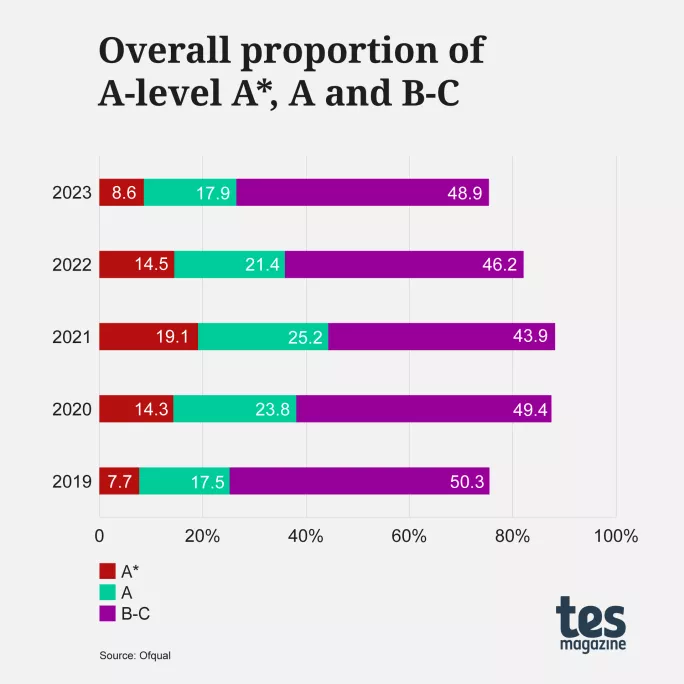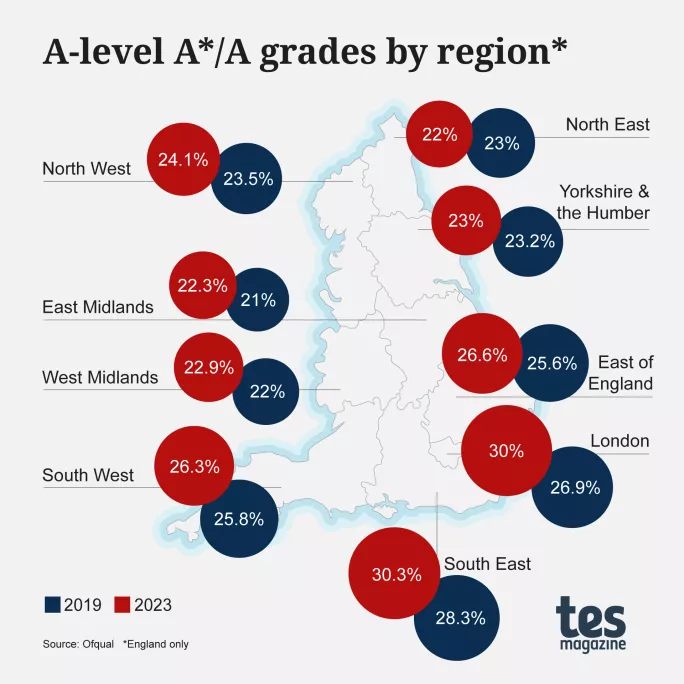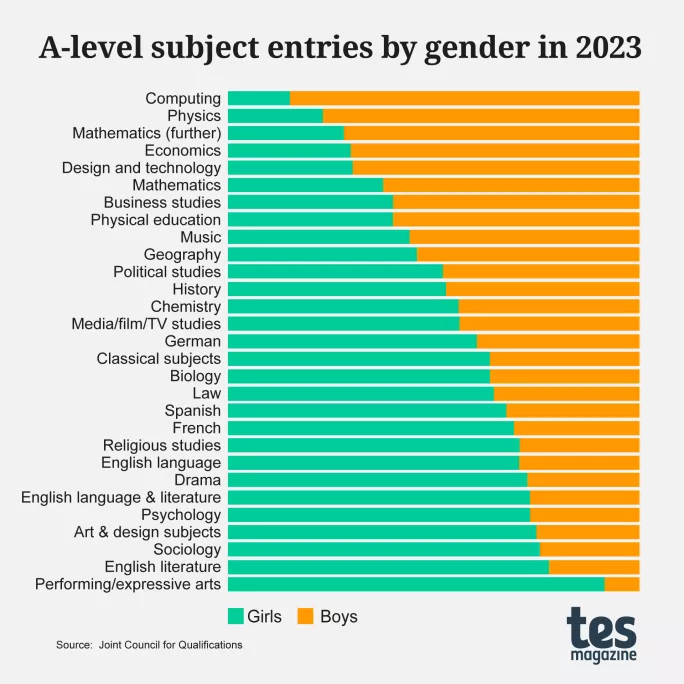A levels 2023: 10 key insights for teachers

A-level results day 2023 marks the return to pre-pandemic grading, with grades now much closer to 2019 levels.
The plan that Ofqual put in place was designed to reduce the grade inflation that saw record high grades in 2020 when centre-assessed grades (CAGs) were used and then again in 2021 when teacher-assessed grades (TAGs) were used, after exams were cancelled in these years because of the pandemic.
This year grading was given some leniency to mitigate the loss of learning that students experienced during Covid - just not as much leniency as students received in 2022.
So what trends can we see when we compare A-level results from 2023 with those in previous years? And what do the results tell us about this year’s cohort and the impact the pandemic has had on learning? Here we look at key insights from results day:
A-level results 2023: the key insights
1. The downward glide happened as expected
Ofqual’s plan to award lower grades has not thrown up any surprises in terms of overall grades.
The A* attainment rate this year was 8.6 per cent, compared with 7.7 per cent in 2019.
Similarly, the A*/A attainment rate was 26.5 per cent, compared with 25.2 per cent in 2019.
However, the overall A*-C attainment rate - 75.4 per cent - was 0.1 percentage point lower than it was in 2019.

Sam Tuckett, associate director at the Education Policy Institute, said that while students this year had been impacted by this change to grading, the system devised was the most reasonable option available to Ofqual.
“While there was no perfect solution to returning to pre-pandemic grading, the gradual, multi-year approach is a reasonable compromise,” he said.
Multi-academy trust leaders agreed, with Rebecca Boomer-Clark, CEO of Academies Enterprise Trust, a trust with 57 schools, saying that the comparisons with 2019 are “fair” and that “grade inflation served no one”. Mohsen Ojja, CEO of Anthem Schools Trust, a trust with 16 schools, echoed these comments.
“It would appear that the transition back to pre-pandemic grading has not been as brutal as some have been predicting,” he said.
“Ofqual has given plenty of information and been very open about the approach, which has meant that rather than looking at last year’s outcomes for comparison, schools have looked at 2019 and, broadly speaking, results have been largely in line with those, with some slightly above.”
2. Grade Us and Es increase
To make this shift down possible, grades at lower levels had to increase - which has played out with the proportion of E grades rising from 5 per cent in 2022 to 7.5 per cent this year.
In addition to this, the number of U grades has also risen, from 1.6 per cent in 2022 to 2.5 per cent in 2023.
This means that almost one in 10 of all grades awarded this summer have been E or ungraded - the highest-ever proportion.
Although this may have been expected up to a point due to the need to bring grades back down, the situation could also have been exacerbated by this cohort feeling overly confident in certain subjects because of outcomes in 2021 at GCSE, when they received the inflated TAGs.
However, the return to pre-pandemic grading combined with a step up in difficulty may have caused more students to underperform, leading to the rise in lower grades.
And, given that Ofqual still applied some level of generosity for grade boundaries this year, the number of E and U grades could have been even higher.
3. Regional attainment concerns
Although all grades have dropped in general, as expected, the regional variation is significant: grades in the South East of England fell far less than those in the North East.
Specifically, the North East saw its proportion of A*/A grades falling to 22 per cent from 30.8 per cent - leaving it below its 2019 level of 23 per cent.
On this measure, the South East fell from 39.5 per cent in 2022 to 30.3 per cent - still two percentage points above 2019 (28.3 per cent).
This means the attainment gap between the two regions has widened from 5.3 per cent in 2019 to 8.3 per cent this year.
In Yorkshire and the Humber a lower proportion of entries were awarded A or A* than in 2019, with the share of top grades decreasing from 23.2 per cent in 2019 to 23 per cent in 2023.
London, meanwhile, saw its proportion of A*/A rise by 3.1 percentage points, from 26.9 to 30 per cent.
Tuckett said this situation was concerning in terms of it further embedding a disadvantage gap between regions.
“The falling outcomes in parts of northern England, where disadvantage levels are higher on average, may be the result of the unequal impact of pandemic on different groups of students,” he said.

4. Independent schools fare best
Another notable data point concerns private schools, with their proportion of A*/A grades up by 2.6 percentage points at 47.4 per cent compared with 44.8 per cent in 2019.
However, for non-private schools, outcomes this year where much closer to the 2019 standard. Academies were 1.4 percentage points higher on this A*/A measure, at 25.4 per cent, while selective schools achieved 39 per cent of A/A*s, up two percentage points on 2019.
Meanwhile, secondary modern schools were only up 0.8 percentage points at 19.1 per cent, while secondary comprehensives were up 1.9 percentage points at 22 per cent.
5. Boys vs girls A/A* battle
For the fourth year running girls outperformed boys, with 27 per cent of girls awarded an A grade and above, compared with 26.5 per cent of boys.
However, boys performed better in terms of A*, with 8.9 per cent achieving a grade at this level, compared with 8.5 per cent of girls.

Girls, though, edged it slightly when it came to the hallowed three A*s achievement, with 2,101 receiving this outcome, compared with 1,719 boys.
Overall, the total number receiving three As this year - 3,820 - was down on the past three years but up on 2019, when it was 2,785.
6. Gender divide in subject choices
Another area of gender difference can be seen in subject choices, with Joint Council for Qualifications data showing that boys heavily favour subjects including computing, physics, further maths and economics.
Girls, meanwhile, mostly account for entries in English literature, psychology and sociology, as well as performing/expressive arts.
It should be noted, though, that this year’s entries do not show a clear Stem v Shape divide, with more girls taking chemistry and biology than boys.
Despite this, Jo Foster, director of The Institute for Research in Schools (IRIS), said the “stark contrast” between girls and boys taking computing, maths and physics was “saddening” and showed there is a long way to go to “close the gender gap in Stem participation”.
“Careers in computing, physics and maths are well paid and in high demand, and we need to support and encourage girls to study these subjects and progress into these careers,” she added.
She said it was vital that schools did not make girls feel these subjects were not for them - this is often cited by girls as a reason for not taking them.
“Research from the Aspires project, for example, found that boys aged between 10 and 18 were significantly more likely than girls to say that their teacher expected them to do well in science, and to feel that their teacher was interested in whether they understood science,” she said.
“The research found that girls often did not feel ‘clever enough’ to do physics, even though girls achieve similar grades to boys.”

7. Maths remains the most popular A level
Data from JCQ also makes it clear that maths has retained its position as the most popular subject choice, with 96,853 entries - 11.2 per cent of the total number.
The most popular subjects after maths were, in order, psychology, biology, chemistry, history and then sociology.
Business studies moved up a place from eighth to seventh, swapping with art and design subjects. Economics broke into the top 10, placing ninth, and physics dropped from ninth to tenth. Geography was the subject to fall out of the top 10.

Meanwhile, the subject to see the biggest increase in entries was computing, rising by 16.7 per cent to 18,306 entries, followed by media/film/TV studies, rising 10 per cent, and politics, rising 8 per cent.
8. Languages in decline
It was less good news for languages, with entries for German, French and Spanish all falling by 10 per cent or more - underlining wider concerns around the ongoing decine of MFL subjects.
Specifically, German fell 15.9 per cent, French fell 10.9 per cent and Spanish 10.8 per cent.
David Blow, a fellow at the Association for Language Learning, said the decline has to be a wake-up call that grading in languages at GCSE has to be “addressed by Ofqual and DfE” so that more students feel confident taking these subjects at A level.
“Systematically, arising from a historical anomaly, students on average get half a grade lower in their GCSE [in modern languages] compared with their other EBacc subjects, leading to a false perception that they are not as good at ML as other subjects, and therefore less likely to take it at A level,” he said.
Other subjects to fall were performing/expressive arts (down 12.8 per cent), drama (down 7.6 per cent), English language (down 7.5 per cent) and music (down 7.2 per cent).

Commenting on the decline in religious studies, Sarah Lane Cawte, chair of the Religious Education Council of England and Wales (REC), said uptake was being hurt by the wider teacher recruitment and retention crisis that meant fewer schools could offer RE teaching at A level, hurting the subject.
“For the last two decades, A-level religious studies has been a success story with growing numbers of entries and impressive results that have opened up a world of opportunity,” she said.
“That legacy is now threatened. A teacher training bursary and a fair allocation of resources to the subject would help reverse this trend and ensure RE continues to thrive as it has done for the last decades.”
9. Fewer students doing four A levels
The number of students taking four or more A levels also declined this year - perhaps in recognition that grades were set to fall. In 2022 13,135 students took four A levels while this year the number was 12,895. Of those to take four A levels, 1,640 achieved all A*s.
However, the number taking five or more actually rose, from 185 last year to 210 this year. Of these 50 secured all A*s.
No one was tempted by six A levels with JCQ not listing anyone taking this number - whereas last year five hardy students did this number.
10. AS-level interest falls again
Also out today are the AS-level exam results, and, like A-level results, there has been a dip in the top grades when compared with 2022, and they have moved closer to pre-pandemic levels.
Over a quarter of all grades were the top grade of A (26.8 per cent), down from nearly one-third last year (30.6 per cent).
Overall, entries for the AS have decreased again when compared with 2022, and this follows a pattern in a reduction of entries that began when A levels were reformed in 2015. Only 60,530 entries were made this year, almost half the number entered in 2019.
This suggests schools are choosing instead to focus more on A levels only, likely due to the fact that the AS qualification is now “standalone” and cannot count towards a full A level.
Register with Tes and you can read two free articles every month plus you'll have access to our range of award-winning newsletters.
Keep reading with our special offer!
You’ve reached your limit of free articles this month.
- Unlimited access to all Tes magazine content
- Save your favourite articles and gift them to your colleagues
- Exclusive subscriber-only stories
- Over 200,000 archived articles
- Unlimited access to all Tes magazine content
- Save your favourite articles and gift them to your colleagues
- Exclusive subscriber-only stories
- Over 200,000 archived articles
topics in this article



